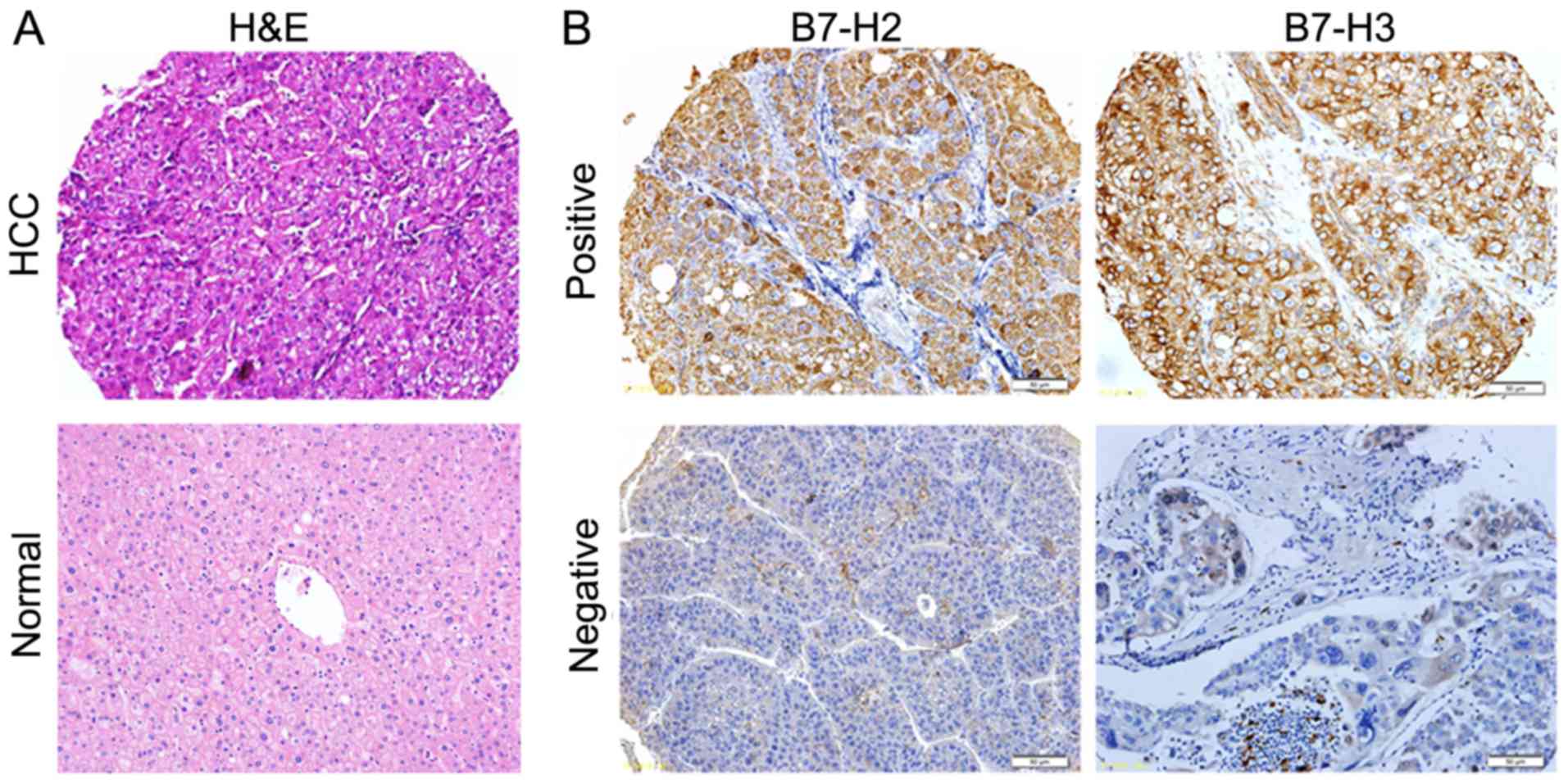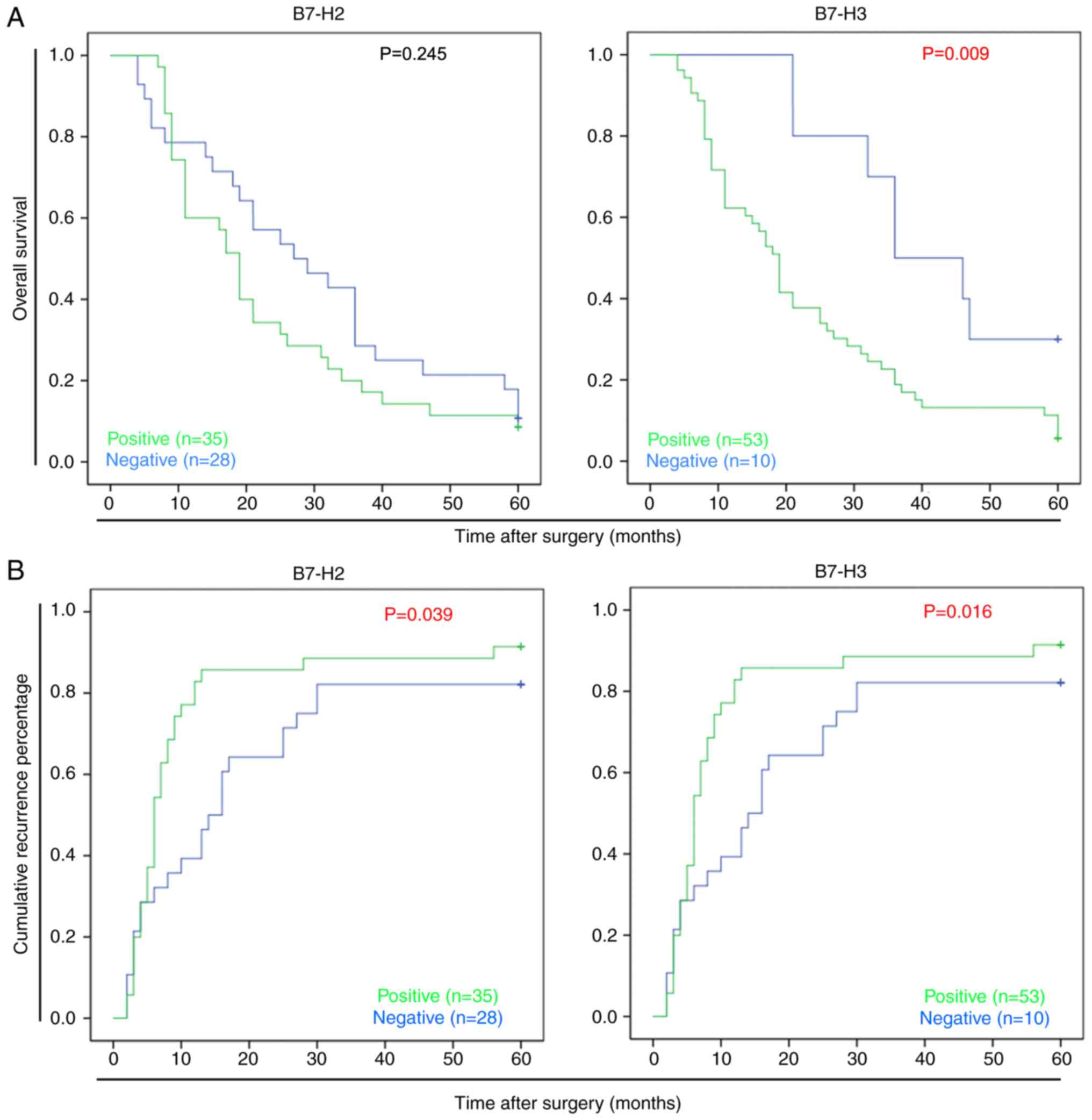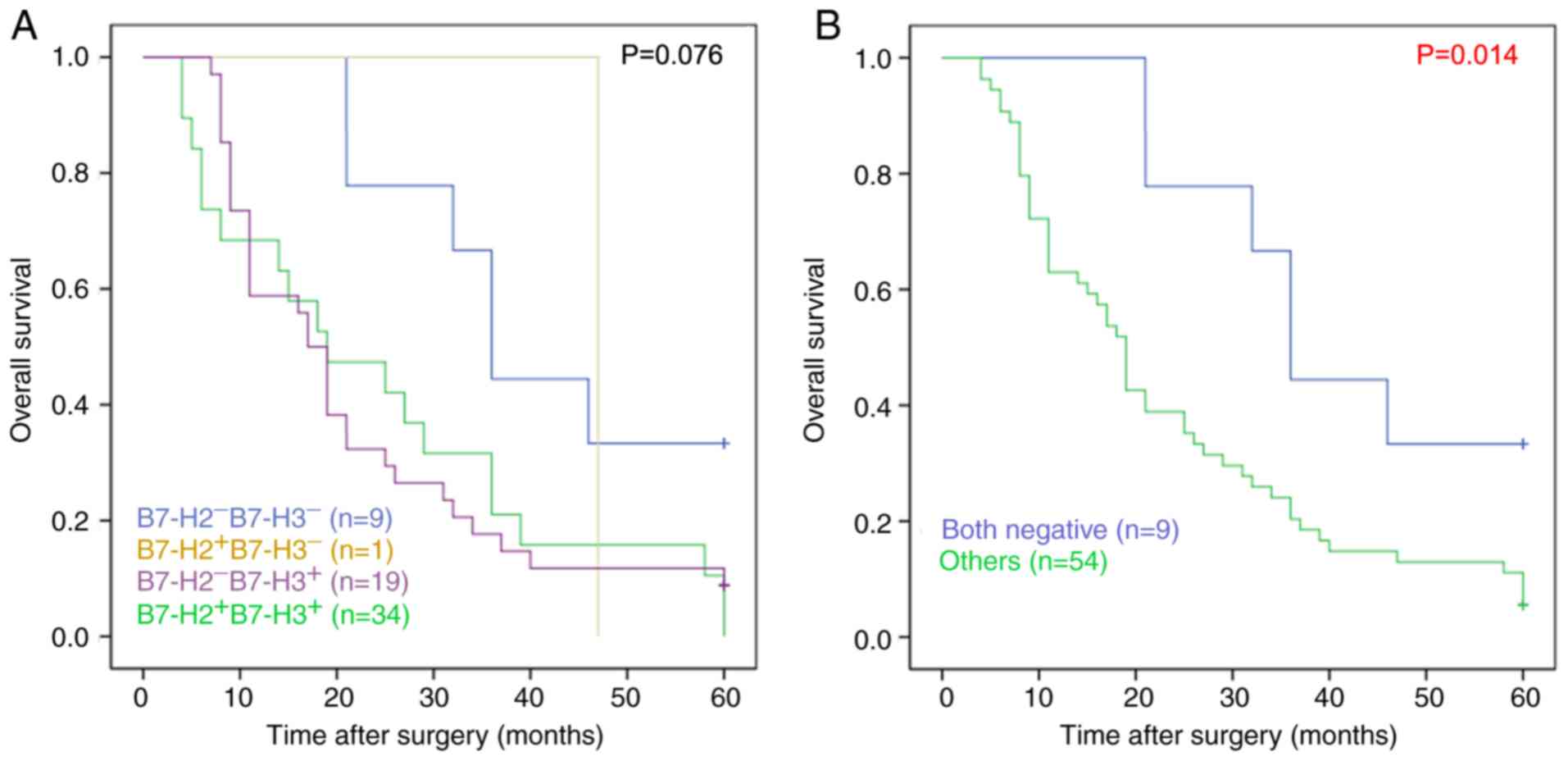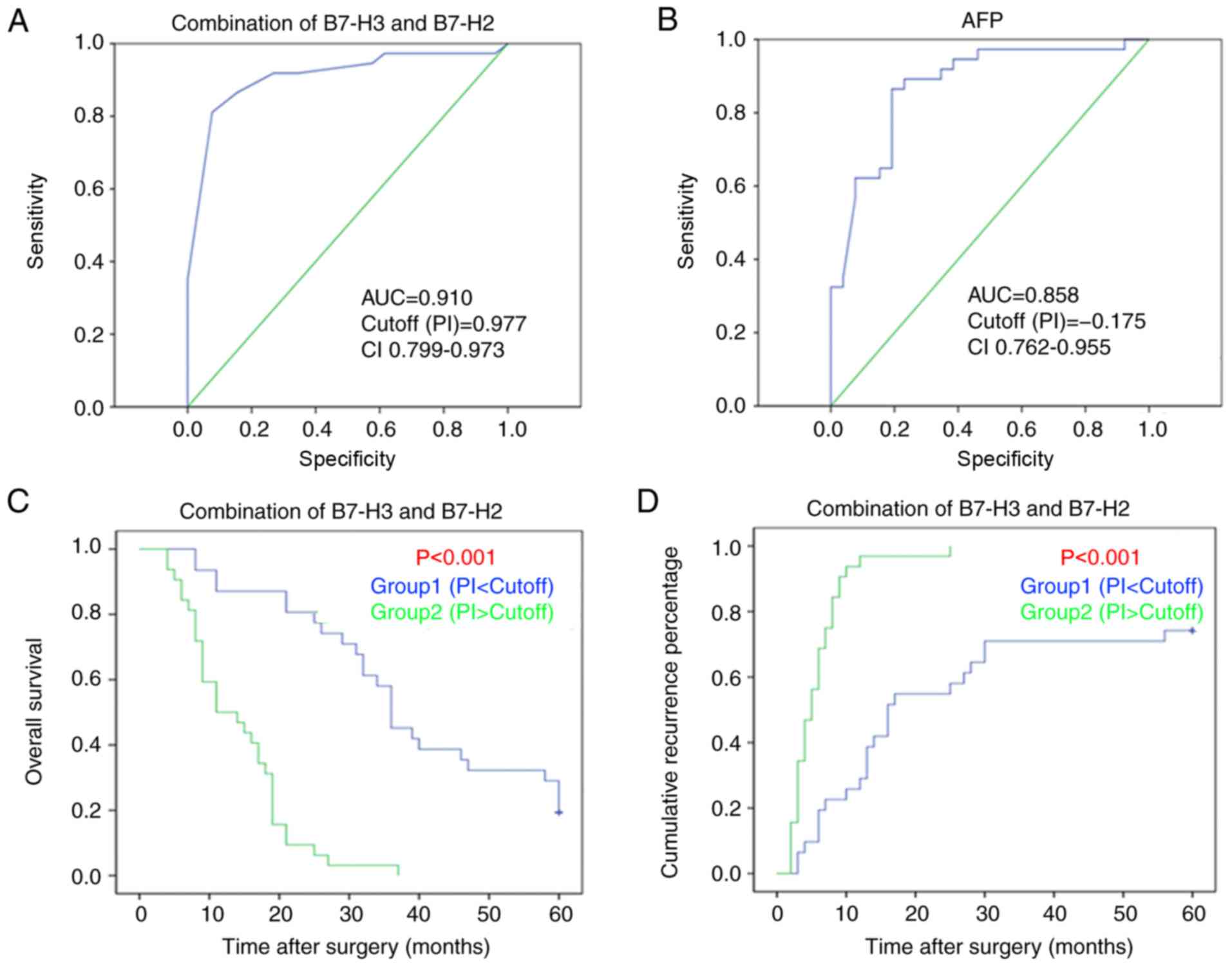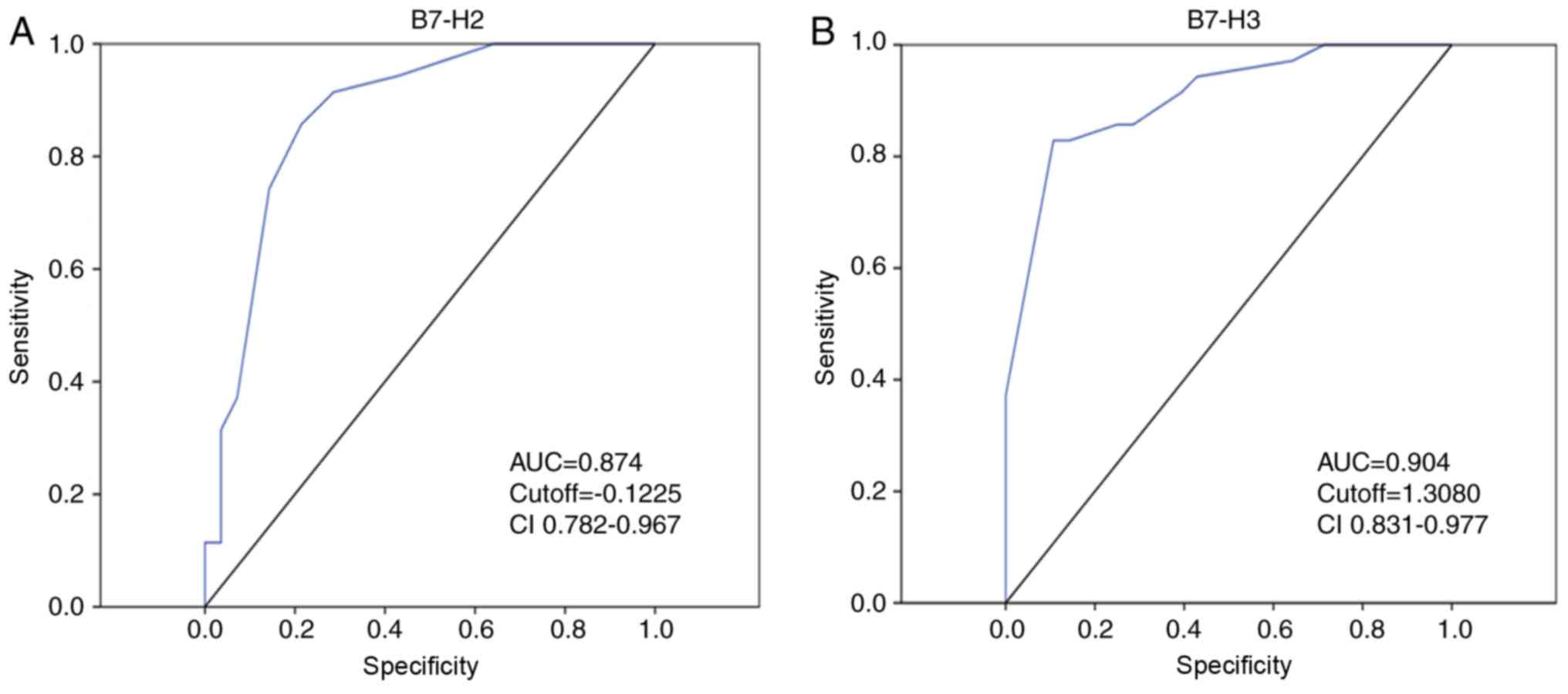|
1
|
Pan R, Zhu M, Yu C, Lv J, Guo Y, Bian Z,
Yang L, Chen Y, Hu Z, Chen Z, et al: Cancer incidence and
mortality: A cohort study in China, 2008–2013. Int J Cancer.
141:1315–1323. 2017. View Article : Google Scholar : PubMed/NCBI
|
|
2
|
Chen WQ, Zheng RS and Zhang SW: Liver
cancer incidence and mortality in China, 2009. Chin J Cancer.
32:162–169. 2013. View Article : Google Scholar : PubMed/NCBI
|
|
3
|
Forner A and Bruix J: Biomarkers for early
diagnosis of hepatocellular carcinoma. Lancet Oncol. 13:750–751.
2012. View Article : Google Scholar : PubMed/NCBI
|
|
4
|
Braillon A: Hepatocellular carcinoma.
Lancet. 380:469author reply 470, 471. 2012. View Article : Google Scholar : PubMed/NCBI
|
|
5
|
Worns MA and Galle PR: Immune oncology in
hepatocellular carcinoma-hype and hope. Lancet. 389:2448–2449.
2017. View Article : Google Scholar : PubMed/NCBI
|
|
6
|
Xu Z, Shen J, Wang MH, Yi T, Yu Y, Zhu Y,
Chen B, Chen J, Li L, Li M, et al: Comprehensive molecular
profiling of the B7 family of immune-regulatory ligands in breast
cancer. Oncoimmunology. 5:e12078412016. View Article : Google Scholar : PubMed/NCBI
|
|
7
|
Hong B, Qian Y, Zhang H, Sang YW, Cheng
LF, Wang Q, Gao S, Zheng M and Yao HP: Expression of B7-H4 and
hepatitis B virus X in hepatitis B virus-related hepatocellular
carcinoma. World J Gastroenterol. 22:4538–4546. 2016. View Article : Google Scholar : PubMed/NCBI
|
|
8
|
Kang FB, Wang L, Jia HC, Li D, Li HJ,
Zhang YG and Sun DX: B7-H3 promotes aggression and invasion of
hepatocellular carcinoma by targeting epithelial-to-mesenchymal
transition via JAK2/STAT3/Slug signaling pathway. Cancer Cell Int.
15:452015. View Article : Google Scholar : PubMed/NCBI
|
|
9
|
Leung J and Suh WK: The CD28-B7 Family in
anti-tumor immunity: Emerging concepts in cancer immunotherapy.
Immune Netw. 14:265–276. 2014. View Article : Google Scholar : PubMed/NCBI
|
|
10
|
Dong H, Zhu G, Tamada K and Chen L: B7-H1,
a third member of the B7 family, co-stimulates T-cell proliferation
and interleukin-10 secretion. Nat Med. 5:1365–1369. 1999.
View Article : Google Scholar : PubMed/NCBI
|
|
11
|
Mao Y, Chen L, Wang F, Zhu D, Ge X, Hua D
and Sun J: Cancer cell-expressed B7-H3 regulates the
differentiation of tumor-associated macrophages in human colorectal
carcinoma. Oncol Lett. 6177–6183. 2017.PubMed/NCBI
|
|
12
|
Jung HI, Jeong D, Ji S, Ahn TS, Bae SH,
Chin S, Chung JC, Kim HC, Lee MS and Baek MJ: Overexpression of
PD-L1 and PD-L2 is associated with poor prognosis in patients with
hepatocellular carcinoma. Cancer Res Treat. 49:246–254. 2017.
View Article : Google Scholar : PubMed/NCBI
|
|
13
|
Calderaro J, Rousseau B, Amaddeo G, Mercey
M, Charpy C1, Costentin C, Luciani A, Zafrani ES, Laurent A,
Azoulay D, et al: Programmed death ligand 1 expression in
hepatocellular carcinoma: Relationship with clinical and
pathological features. Hepatology. 64:2038–2046. 2016. View Article : Google Scholar : PubMed/NCBI
|
|
14
|
Vigdorovich V, Ramagopal UA, Lazar-Molnar
E, Sylvestre E, Lee JS, Hofmeyer KA, Zang X, Nathenson SG and Almo
SC: Structure and T cell inhibition properties of B7 family member,
B7-H3. Structure. 21:707–717. 2013. View Article : Google Scholar : PubMed/NCBI
|
|
15
|
Tu JF, Ding YH, Ying XH, Wu FZ, Zhou XM,
Zhang DK, Zou H and Ji JS: Regulatory T cells, especially ICOS+
FOXP3+ regulatory T cells, are increased in the hepatocellular
carcinoma microenvironment and predict reduced survival. Sci Rep.
6:350562016. View Article : Google Scholar : PubMed/NCBI
|
|
16
|
Pahwa A, Beckett K, Channual S, Tan N, Lu
DS and Raman SS: Efficacy of the American association for the study
of liver disease and Barcelona criteria for the diagnosis of
hepatocellular carcinoma. Abdom Imaging. 39:753–760. 2014.
View Article : Google Scholar : PubMed/NCBI
|
|
17
|
Hwang M, Jayakrishnan TT, Green DE, George
B, Thomas JP, Groeschl RT, Erickson B, Pappas SG, Gamblin TC and
Turaga KK: Systematic review of outcomes of patients undergoing
resection for colorectal liver metastases in the setting of extra
hepatic disease. Eur J Cancer. 50:1747–1757. 2014. View Article : Google Scholar : PubMed/NCBI
|
|
18
|
Ng KM, Yan TD, Black D, Chu FC and Morris
DL: Prognostic determinants for survival after resection/ablation
of a large hepatocellular carcinoma. HPB (Oxford). 11:311–320.
2009. View Article : Google Scholar : PubMed/NCBI
|
|
19
|
Choi GH, Han DH, Kim DH, Choi SB, Kang CM,
Kim KS, Choi JS, Park YN, Park JY, Kim DY, et al: Outcome after
curative resection for a huge (>or=10 cm) hepatocellular
carcinoma and prognostic significance of gross tumor
classification. Am J Surg. 198:693–701. 2009. View Article : Google Scholar : PubMed/NCBI
|
|
20
|
Lee SG, Hwang S, Jung JP, Lee YJ, Kim KH
and Ahn CS: Outcome of patients with huge hepatocellular carcinoma
after primary resection and treatment of recurrent lesions. Br J
Surg. 94:320–326. 2007. View
Article : Google Scholar : PubMed/NCBI
|
|
21
|
Liu Y, Wang YR, Dingi GH, Yang TS, Jiang
SL, Wang L, Xun LJ, Song RM, Song ZS and Zhou B: Influence of
surgical resection of hepatocellular carcinoma(HCC) for
hematogenous dissemination of HCC cells and its effect on
recurrence and metastasis: 3 years prospective study. Neoplasma.
62:635–640. 2015. View Article : Google Scholar : PubMed/NCBI
|
|
22
|
Xu B, Cai Z, Zeng Y, Chen L, Du X, Huang
A, Liu X and Liu J: Alpha-Methylacyl-CoA racemase (AMACR) serves as
a prognostic biomarker for the early recurrence/metastasis of HCC.
J Clin Pathol. 67:974–979. 2014. View Article : Google Scholar : PubMed/NCBI
|
|
23
|
Jiang YF, Yang ZH and Hu JQ: Recurrence or
metastasis of HCC: Predictors, early detection and experimental
antiangiogenic therapy. World J Gastroenterol. 6:61–65. 2000.
View Article : Google Scholar : PubMed/NCBI
|
|
24
|
Kang TW, Yevsa T, Woller N, Hoenicke L,
Wuestefeld T, Dauch D, Hohmeyer A, Gereke M, Rudalska R, Potapova
A, et al: Senescence surveillance of pre-malignant hepatocytes
limits liver cancer development. Nature. 479:547–551. 2011.
View Article : Google Scholar : PubMed/NCBI
|
|
25
|
Petruzziello A: Epidemiology of hepatitis
B virus (HBV) and hepatitis C virus (HCV) related hepatocellular
carcinoma. Open Virol J. 12:26–32. 2018. View Article : Google Scholar : PubMed/NCBI
|
|
26
|
Liu CJ and Kao JH: Hepatitis B
virus-related hepatocellular carcinoma: Epidemiology and pathogenic
role of viral factors. J Chin Med Assoc. 70:141–145. 2007.
View Article : Google Scholar : PubMed/NCBI
|
|
27
|
Blachier M, Leleu H, Peck-Radosavljevic M,
Valla DC and Roudot-Thorav F: The burden of liver disease in
Europe: A review of available epidemiological data. J Hepatol.
58:593–608. 2013. View Article : Google Scholar : PubMed/NCBI
|
|
28
|
Sumie S, Kawaguchi T, Komuta M, Kuromatsu
R, Itano S, Okuda K, Taniguchi E, Ando E, Takata A, Fukushima N, et
al: Significance of glucose intolerance and SHIP2 expression in
hepatocellular carcinoma patients with HCV infection. Oncol Rep.
18:545–552. 2007.PubMed/NCBI
|
|
29
|
Kawaguchi T, Nakano D, Okamura S, Shimose
S, Hayakawa M, Niizeki T, Koga H and Torimura T: Spontaneous
regression of hepatocellular carcinoma with reduction in
angiogenesis-related cytokines after treatment with sodium-glucose
cotransporter 2 inhibitor in a cirrhotic patient with diabetes
mellitus. Hepatol Res. 2018 Sep;4.Doi: 10.1111/hepr.13247.
|
|
30
|
Chen L, Xie Q, Wang Z, Shi L, Wu C and
Jiang J: Assessment of combined expression of B7-H3 and B7-H4 as
prognostic marker in esophageal cancer patients. Oncotarget.
7:77237–77243. 2016.PubMed/NCBI
|
|
31
|
Burris HA, Callahan MK, Tolcher AW, Kummar
S, Falchook GS, Pachynski RK, Tykodi SS, Gibney GT, Seiwert TY,
Gainor JF, et al: Phase 1 safety of ICOS agonist antibody JTX-2011
alone and with nivolumab (nivo) in advanced solid tumors; predicted
vs. observed pharmacokinetics (PK) in ICONIC. J Clin Oncol.
15:3033. 2017. View Article : Google Scholar
|















